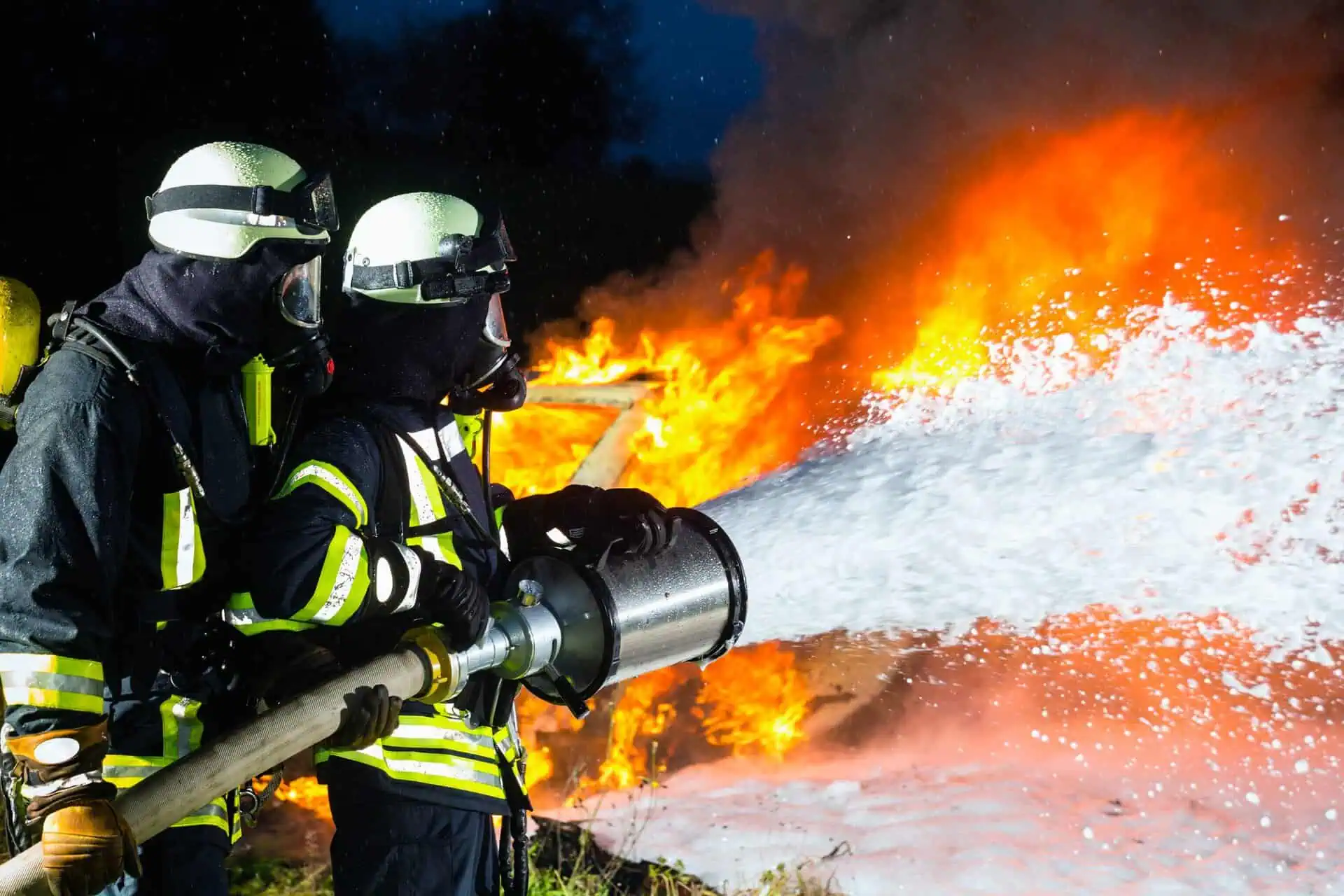Air Force Firefighting Foam Lawsuit
- Last Updated: June 12th, 2025

Attorney Jessica Paluch-Hoerman, founder of TruLaw, has over 28 years of experience as a personal injury and mass tort attorney, and previously worked as an international tax attorney at Deloitte. Jessie collaborates with attorneys nationwide — enabling her to share reliable, up-to-date legal information with our readers.
Legally Reviewed
This article has been written and reviewed for legal accuracy and clarity by the team of writers and legal experts at TruLaw and is as accurate as possible. This content should not be taken as legal advice from an attorney. If you would like to learn more about our owner and experienced injury lawyer, Jessie Paluch, you can do so here.
Fact-Checked
TruLaw does everything possible to make sure the information in this article is up to date and accurate. If you need specific legal advice about your case, contact us by using the chat on the bottom of this page. This article should not be taken as advice from an attorney.
Key takeaways:
- AFFF contains harmful PFAS chemicals linked to cancers and other health issues, leading to over 100 new legal claims each month.
- Victims of AFFF exposure in the military or near bases are fighting for compensation due to its long-term health risks.
- The EPA's proposed drinking water standards highlight the dangers of PFAS, becoming critical evidence in lawsuits.
Air Force Firefighting Foam Lawsuit: Overview and Claims
On this page, we’ll discuss the Air Force Firefighting Foam Lawsuit, potential health risks linked to AFFF exposure, the history of AFFF use in the military, and much more.
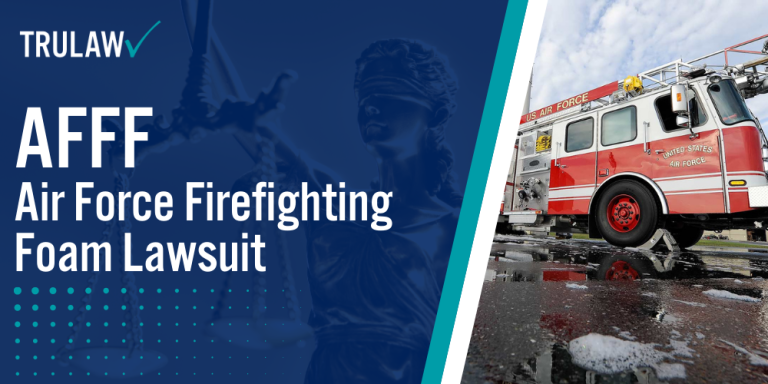
Intro to the Air Force Firefighting Foam Lawsuit
Military firefighters, along with other current and former military personnel, have been filing lawsuits related to health issues stemming from exposure to aqueous film-forming foam (AFFF).
This foam has been extensively used for its fire-suppressing capabilities.
Many service members may have been exposed to toxic firefighting foam during their time in the Air Force, as AFFF was a common tool for extinguishing fires on military bases.
The foam contains PFAS chemicals, often called “forever chemicals,” which do not break down easily and persist in the environment and the human body.
Exposure to PFAS chemicals has been linked to several severe health risks, including prostate, kidney, and testicular cancer, thyroid conditions, and infertility.
If you served in the US Air Force, were exposed to AFFF firefighting foam, and later developed cancer or other health concerns, you may be eligible to pursue legal action through an AFFF lawsuit.
You can use the chatbot on this page to instantly determine if you qualify to file an AFFF lawsuit.
The experienced firefighting foam lawyers at TruLaw and our partner law firms are here to guide individuals through the legal process and provide support to those affected by firefighting foam exposure.
Table of Contents
Historical Use of Aqueous Film Forming Foam (AFFF) in the US Military
Aqueous film-forming foam (AFFF) was developed as a highly effective solution for extinguishing flammable liquid fires.
Its unique chemical properties allowed it to quickly suppress flames and prevent re-ignition by creating a protective barrier.
In collaboration with 3M, the U.S. Military began developing AFFF in the 1960s.
Following the tragic fire aboard the USS Forrestal in 1967, which claimed the lives of 134 sailors, the Navy made it mandatory for all vessels to carry AFFF firefighting foam.
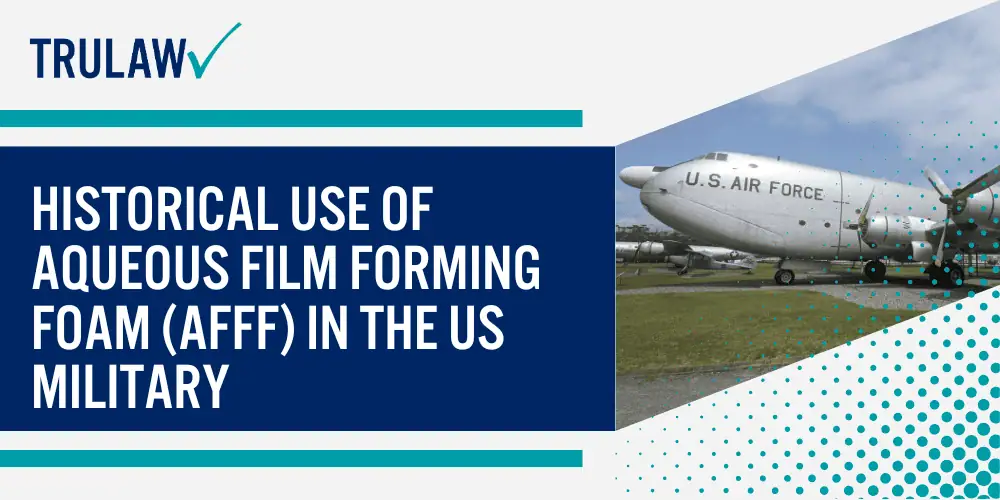
This marked the beginning of widespread use of AFFF across various military branches, including the Air Force.
Over the decades, AFFF became a major tool used at military bases, airfields, aircraft carriers, and other facilities to combat flammable liquid fires.
AFFF’s Role in Combating Flammable Liquid Fires on Military Bases
Military installations, especially those involving aviation fuels and hazardous liquids, required a powerful firefighting solution.
AFFF was integral to fire safety strategies across Air Force bases and other military environments, due to its ability to suppress fires quickly and prevent them from reigniting.
From training exercises to real-life emergencies, AFFF was regularly deployed to prevent catastrophic fires and protect both personnel and property.
Extensive Use of AFFF by the U.S. Air Force
In the 1970s, AFFF became an integral part of firefighting protocols in the U.S. Air Force, used in various situations ranging from emergency responses on airfields to routine fire safety drills.
Firefighters and other military personnel were frequently exposed to the foam during daily operations.
However, the properties enabling AFFF’s effectiveness are also responsible for the growing list of health issues linked to long-term AFFF exposure.
From spills and accidents to regular handling and disposal, the risk of exposure to toxic PFAS chemicals is an ongoing issue for military personnel.
These health risks have led to numerous lawsuits from former service members, highlighting the need for greater awareness and legal action surrounding AFFF use in the military.
Health Hazards Linked to AFFF Exposure
Aqueous Film Forming Foam (AFFF) has been widely used by various industries, including the U.S. Military, since the 1960s.
Many AFFF products contain polyfluoroalkyl substances (PFAS) — synthetic, toxic chemicals that have raised influential health concerns.
These “forever chemicals” are persistent in the environment and the human body, and scientific studies have linked them to serious health risks, including various types of cancer.
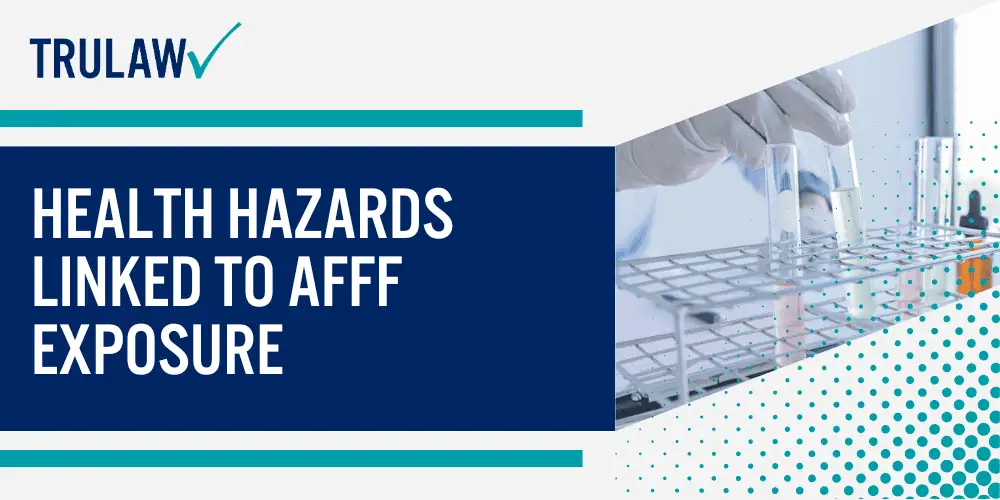
Organizations such as the U.S. Environmental Protection Agency (EPA), the Centers for Disease Control and Prevention (CDC), and the Agency for Toxic Substances and Disease Registry (ATSDR) have all recognized the potential dangers of PFAS chemicals and continue to study their long-term effects on human health.
Pathways of Exposure for AFFF Chemicals to Enter the Body
For decades, AFFF has been used in firefighting efforts, especially by the U.S. Military in training exercises and emergency situations.
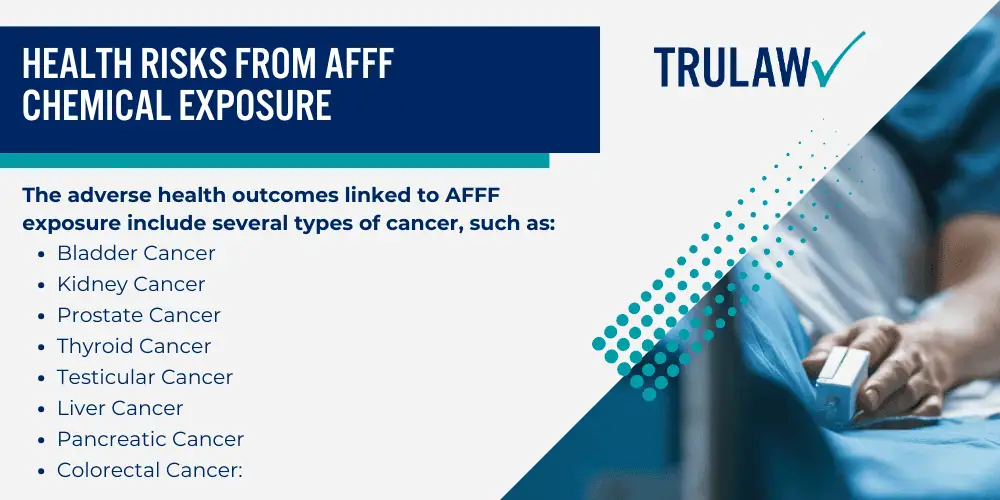
Individuals who worked closely with AFFF may have been exposed to PFAS chemicals in multiple ways:
- Inhalation of Vapors and Particles: During the application or cleanup of AFFF, individuals may have inhaled airborne particles, posing major respiratory risks.
- Direct Skin Contact: Firefighters and military personnel could have been exposed through direct contact with AFFF foam, leading to potential contamination through the skin.
- Ingestion Through Contaminated Water or Food: PFAS chemicals may have entered local groundwater sources, affecting drinking water and food supplies, potentially impacting both workers and nearby communities.
Health Risks from AFFF Chemical Exposure
Health risks linked to exposure to AFFF-related PFAS chemicals are a growing concern.
Many individuals are coming forward to pursue legal claims as they grapple with the serious health effects linked to these chemicals.
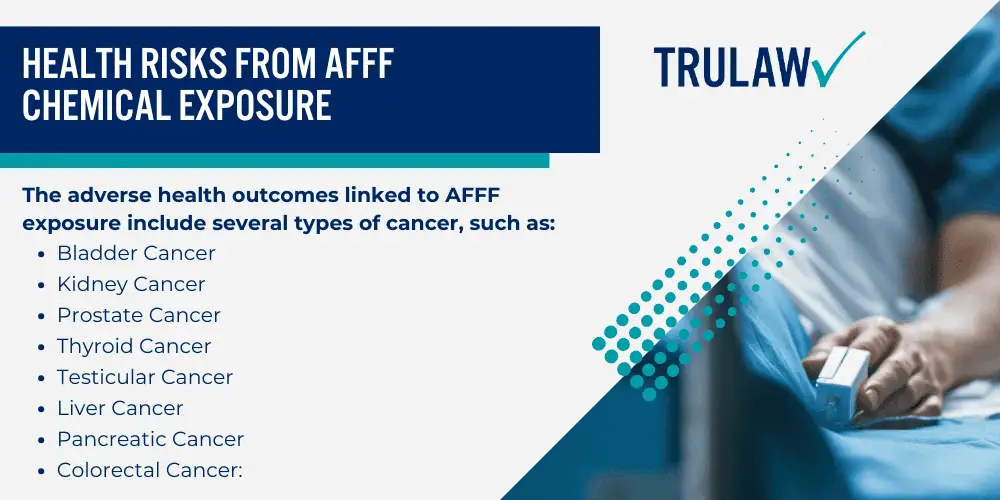
The adverse health outcomes linked to AFFF exposure include several types of cancer, such as:
- Bladder Cancer: Research indicates that the accumulation of PFAS in the bladder may lead to cancer, with concerns about DNA damage contributing to this risk.
- Kidney Cancer: Studies suggest PFAS chemicals may accumulate in the body over time, contributing to the risk of kidney cancer.
- Prostate Cancer: PFAS chemicals are known endocrine disruptors, and studies suggest a correlation between AFFF exposure and prostate cancer.
- Thyroid Cancer: Disruptions in thyroid hormone production linked to PFAS exposure raise the risk of thyroid cancer.
- Testicular Cancer: PFAS may interfere with hormonal balance, contributing to an increased risk of testicular cancer.
- Liver Cancer: PFAS compounds may disrupt liver function, potentially leading to liver cancer after prolonged exposure.
- Pancreatic Cancer: There is concern that PFAS exposure could impair pancreatic function, potentially leading to pancreatic cancer.
- Colorectal Cancer: Emerging evidence points to a link between AFFF exposure and colorectal cancer, likely due to chronic inflammation and genetic damage.
Additional Health Issues Related to PFAS Exposure
In addition to cancer, exposure to PFAS chemicals found in AFFF is associated with a range of other health issues.
These potential risks include:
- Reproductive Issues: PFAS exposure has been linked to fertility issues, pregnancy complications, and developmental abnormalities in children.
- Developmental Delays: Children exposed to PFAS chemicals may experience cognitive or motor skill delays, potentially affecting their long-term development.
- Immune System Disruption: PFAS chemicals can weaken the immune system, increasing susceptibility to infections and other illnesses.
- Hormonal Imbalance: PFAS compounds may disrupt the endocrine system, leading to a range of hormone-related health problems.
- Eye and Skin Damage: Direct contact with AFFF may cause irritation or damage to the skin and eyes, with prolonged exposure leading to more severe conditions.
- Respiratory Problems: Inhalation of PFAS particles can contribute to respiratory issues such as coughing, wheezing, and long-term breathing difficulties.
- Neurological Challenges: PFAS exposure may be linked to cognitive impairments, memory loss, and other neurological disorders as these chemicals can cross the blood-brain barrier.
These health risks continue to be investigated, and we encourage individuals who may have been exposed to AFFF to reach out and explore their legal options.
Submitting VA Disability Claims for AFFF Exposure
Veterans who have experienced health issues linked to AFFF exposure may be eligible to file VA disability claims.
To qualify for VA disability compensation, veterans must demonstrate a direct connection between their military service and the health condition caused by AFFF exposure.
This can be proven with proper documentation, such as medical records, service records, and any evidence of exposure incidents — this evidence can help establish a clear link between AFFF exposure and the health issues that followed.
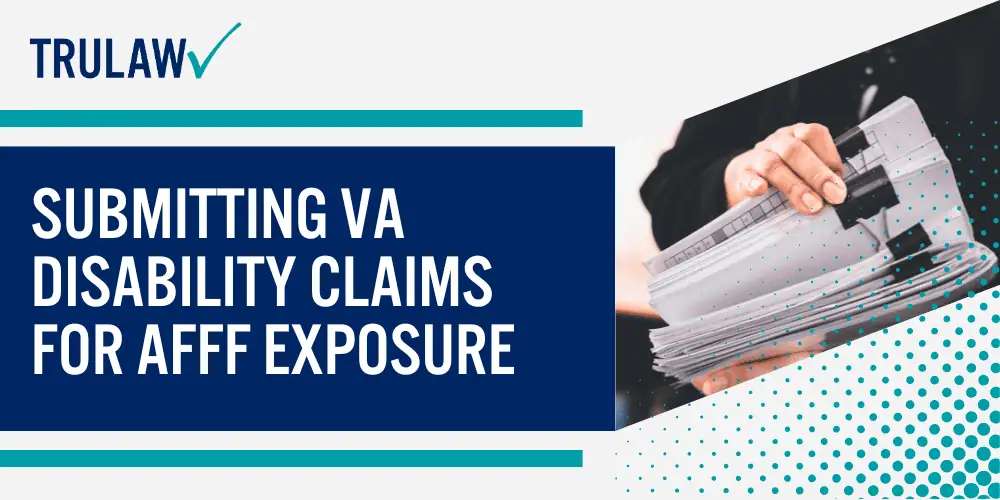
Filing a VA disability claim involves several steps, including completing the required forms, submitting evidence, and potentially attending medical examinations.
For veterans dealing with health complications, this process can be overwhelming.
For more information on how to file VA disability claims related to AFFF exposure, refer to our guide on how the VA disability claims process works for AFFF exposure.
The firefighting foam attorneys at TruLaw and our partner law firms provide individuals with the legal assistance they need and hold these large companies accountable.
Use the chat on this page for an instant case evaluation that can determine if you qualify to file an AFFF lawsuit.
AFFF Firefighting Foam Lawsuits: A Complete Overview
As public awareness of AFFF-related health risks has grown, legal actions have been initiated.
Veterans and current military personnel exposed to AFFF may be eligible to seek legal recourse against the manufacturers of these products.
Individuals who encountered PFAS chemicals during their military service are filing AFFF lawsuits to hold manufacturers accountable for potential health damages.
These lawsuits seek compensation for medical expenses, lost wages, and the emotional toll of illness caused by exposure.
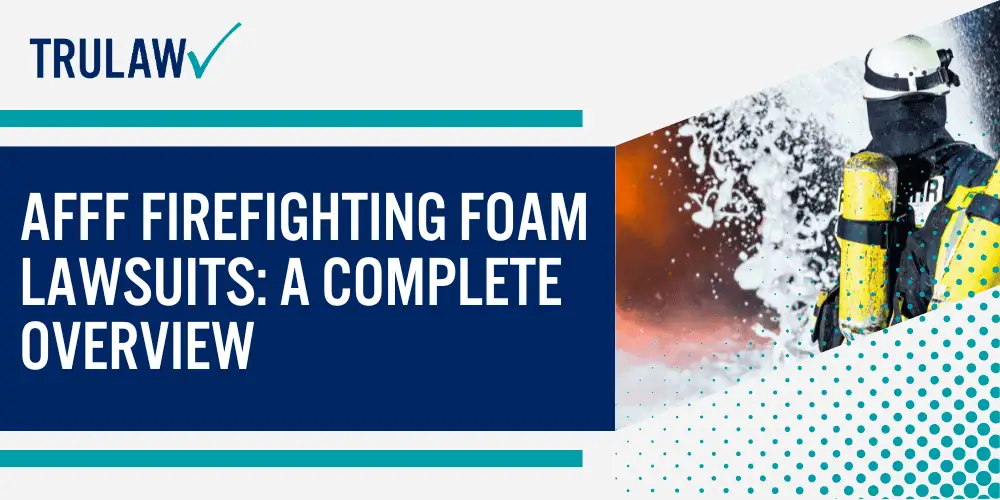
Legal actions against AFFF manufacturers reflect the urgency of addressing the widespread impact of these chemicals.
By pursuing these cases, veterans and their families aim to secure the compensation they may be entitled to for the damages they’ve suffered.
Latest Updates and Growing Awareness
Heightened awareness of the risks associated with PFAS exposure has led to substantial changes in military protocols.
Efforts are underway to phase out AFFF and replace it with safer alternatives, reflecting a commitment to protecting military personnel.
According to the 2020 National Defense Authorization Act (NDAA), the Department of Defense is required to phase out the use of AFFF firefighting foam at all military installations by October 1, 2024.
This initiative is paired with the transition to safer firefighting foam alternatives.
Veterans and public health organizations are actively working together to raise awareness about the health risks associated with AFFF exposure.
These joint efforts focus on research, advocacy, and providing support to those affected.
By bringing together researchers, veterans, legal experts, and public health advocates, these collaborative efforts aim to drive meaningful change, improve regulations, and help ensure that justice is achieved for those impacted by AFFF exposure.
TruLaw: Your Trusted Air Force Firefighting Foam Law Firm
The link between AFFF exposure and subsequent development of various cancers and health issues has become a growing concern for veterans and active military personnel alike.
Veterans affected by long-term AFFF exposure should be aware of their rights and the steps they can take to seek compensation.
Pursuing legal action promptly can make a difference in covering medical expenses and addressing other damages.
AFFF Firefighting Foam Cancer Lawsuits are being filed by individuals who were exposed to firefighting foam and later developed cancer.
The experienced firefighting foam lawyers at TruLaw and our partner law firms work to help veterans, firefighters, and others who have been affected by AFFF exposure across the United States.
If you were exposed to AFFF during your military service and have since been diagnosed with cancer or another related health issue, you may be eligible to file an AFFF lawsuit.
Use the chatbot on this page to instantly determine if you qualify for an AFFF lawsuit.
AFFF Lawsuit Frequently Asked Questions
-
Is AFFF firefighting foam still being used?
The use of AFFF firefighting foam is gradually being phased out, although it is still employed in some industries and emergency situations where alternatives have not yet been implemented.
The U.S. Department of Defense is actively working to replace AFFF and has set a goal to cease using toxic firefighting foam entirely by October 2024.
Industries that still use AFFF firefighting foam include:
- Military Operations: Although the Department of Defense is set to end AFFF use by October 2024, it continues to be used in military settings for emergency situations.
- Aviation Industry: AFFF is still used due to its effectiveness in suppressing liquid fuel fires, which are common in aircraft incidents.
- Petrochemical Plants: AFFF is used in these facilities because of the high risk of large-scale flammable liquid fires.
Efforts to transition away from AFFF firefighting foams (which contain PFAS chemicals) are supported by the National Fire Protection Association (NFPA), which has provided guidance on safer alternatives to AFFF.
-
What does the AFFF firefighting foam MDL include?
The AFFF Firefighting Foam lawsuit is being handled through multidistrict litigation (MDL), which helps consolidate AFFF firefighting foam cases with similar claims to streamline the legal process.
MDL is a way for federal courts to handle major lawsuits more efficiently by grouping similar cases together — allowing for consistent rulings and faster resolutions.
The AFFF MDL is centralized in the U.S. District Court for the District of South Carolina under MDL 2873, where it consolidates both personal injury claims and environmental contamination cases related to AFFF.
-
Is there a class action lawsuit for AFFF?
No, there is no firefighting foam class action lawsuit related to personal injury claims or environmental contamination from AFFF.
Instead, current and pending AFFF lawsuits are consolidated into multidistrict litigation (MDL).
It’s important to note the difference between MDL and class action lawsuits.
In an MDL, plaintiffs retain their individual cases, and any settlement is based on the unique facts of their situation.
By contrast, in a class action lawsuit, all claimants are treated as part of a single “class,” with settlements divided evenly among participants, regardless of individual circumstances.
-
What are the average settlement amounts for AFFF lawsuits?
There has not yet been a settlement in the AFFF firefighting foam lawsuits.
While the AFFF litigation is ongoing, the legal community has projected potential settlement amounts for these cases based on previous mass tort settlements involving cancer diagnoses.
Firefighting foam lawyers estimate that AFFF Lawsuit settlement amounts could range between $20,000 and $600,000 (or more), depending on the specific details and strength of each case.
These figures are projections, not guarantees, and will depend on factors unique to each plaintiff’s claim.
-
How do I know if I qualify for the firefighting foam cancer lawsuit?
If you were exposed to AFFF firefighting foam during military service or other employment and later developed cancer or related health issues, you may be eligible to file an AFFF cancer lawsuit and seek compensation.
AFFF firefighting foam lawyers at TruLaw and our partner law firms can provide you with a free consultation by using the chat on this page for an instant case evaluation to determine if you qualify to file an AFFF firefighting foam cancer lawsuit.
-
What health problems are linked to exposure to PFAS chemicals in AFFF firefighting foam?
Exposure to PFAS chemicals in AFFF firefighting foam has been linked to a range of cancers and other health issues.
Many individuals have filed lawsuits seeking compensation for cancer diagnoses and related damages.
Cancers linked to AFFF exposure include:
- Rectal cancer
- Pancreatic cancer
- Thyroid cancer
- Liver cancer
- Colon cancer
- Colorectal cancer
- Breast cancer
- Testicular cancer
- Kidney cancer
- Prostate cancer
- Bladder cancer
Other potential health risks of AFFF exposure include:
- Decreased vaccine response in children
- Increased risk of high blood pressure or pre-eclampsia in pregnant women
- Changes in liver enzymes
- Small decreases in infant birth weights
- Increased cholesterol levels
These health risks highlight the serious nature of PFAS exposure for those who have been regularly exposed to firefighting foam.

Managing Attorney & Owner
With over 25 years of legal experience, Jessica Paluch-Hoerman is an Illinois lawyer, a CPA, and a mother of three. She spent the first decade of her career working as an international tax attorney at Deloitte.
In 2009, Jessie co-founded her own law firm with her husband – which has scaled to over 30 employees since its conception.
In 2016, Jessie founded TruLaw, which allows her to collaborate with attorneys and legal experts across the United States on a daily basis. This hypervaluable network of experts is what enables her to share the most reliable, accurate, and up-to-date legal information with our readers!
Additional AFFF Lawsuit resources on our website:
Here, at TruLaw, we’re committed to helping victims get the justice they deserve.
Alongside our partner law firms, we have successfully collected over $3 Billion in verdicts and settlements on behalf of injured individuals.
Would you like our help?
At TruLaw, we fiercely combat corporations that endanger individuals’ well-being. If you’ve suffered injuries and believe these well-funded entities should be held accountable, we’re here for you.
With TruLaw, you gain access to successful and seasoned lawyers who maximize your chances of success. Our lawyers invest in you—they do not receive a dime until your lawsuit reaches a successful resolution!
AFFF Lawsuit claims are being filed against manufacturers of aqueous film-forming foam (AFFF), commonly used in firefighting.
Claims allege that companies such as 3M, DuPont, and Tyco Fire Products failed to adequately warn users about the potential dangers of AFFF exposure — including increased risks of various cancers and diseases.
Depo Provera Lawsuit claims are being filed by individuals who allege they developed meningioma (a type of brain tumor) after receiving Depo-Provera birth control injections.
A 2024 study found that women using Depo-Provera for at least 1 year are five times more likely to develop meningioma brain tumors compared to those not using the drug.
Suboxone Tooth Decay Lawsuit claims are being filed against Indivior, the manufacturer of Suboxone, a medication used to treat opioid addiction.
Claims allege that Indivior failed to adequately warn users about the potential dangers of severe tooth decay and dental injuries associated with Suboxone’s sublingual film version.
Social Media Harm Lawsuits are being filed against social media companies for allegedly causing mental health issues in children and teens.
Claims allege that companies like Meta, Google, ByteDance, and Snap designed addictive platforms that led to anxiety, depression, and other mental health issues without adequately warning users or parents.
Transvaginal Mesh Lawsuits are being filed against manufacturers of transvaginal mesh products used to treat pelvic organ prolapse (POP) and stress urinary incontinence (SUI).
Claims allege that companies like Ethicon, C.R. Bard, and Boston Scientific failed to adequately warn about potential dangers — including erosion, pain, and infection.
Bair Hugger Warming Blanket Lawsuits involve claims against 3M — alleging their surgical warming blankets caused severe infections and complications (particularly in hip and knee replacement surgeries).
Plaintiffs claim 3M failed to warn about potential risks — despite knowing about increased risk of deep joint infections since 2011.
Baby Formula NEC Lawsuit claims are being filed against manufacturers of cow’s milk-based baby formula products.
Claims allege that companies like Abbott Laboratories (Similac) and Mead Johnson & Company (Enfamil) failed to warn about the increased risk of necrotizing enterocolitis (NEC) in premature infants.
Here, at TruLaw, we’re committed to helping victims get the justice they deserve.
Alongside our partner law firms, we have successfully collected over $3 Billion in verdicts and settlements on behalf of injured individuals.
Would you like our help?
